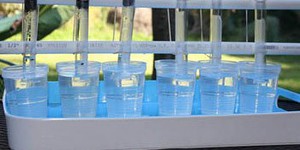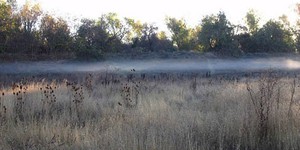Sixth Grade, Weather & Atmosphere Science Projects (17 results)
Everybody talks about the weather, but nobody does anything about it.
- Charles Dudley Warner
Weather and atmospheric science offer lots of opportunities for interesting explorations. It's a satisfyingly complex area, with lots of online resources so you can make your project as easy or as advanced as you want. And when you're done, you'll have a science fair project everyone can talk about.
|
Select a resource
Sort by
|
Tornadoes are a very destructive weather phenomenon that is very hard to predict. Certain weather conditions can indicate if a tornado is likely to occur, but the path that the tornado will take is completely unpredictable. Storm chasers are people who chase tornadoes and try to capture them on film or video. They often have a sense of predicting where and when a tornado will strike, but the best images are also due to a bit of luck and survival instinct. Even though tornadoes are…
Read more
Featured
Have you heard that garlic powder is supposed to inhibit the growth of bacteria? Which do you think would make a better disinfectant: a solution of garlic powder or a solution of bleach? This project shows you a straightforward way to compare the effectiveness of different disinfectants (or other antimicrobial agents), by measuring zones of inhibition on a culture plate.
Read more
Earth's atmosphere, the ocean of air that blankets the planet, is mostly nitrogen and oxygen, with small amounts of other gases. How much oxygen is present in air at sea level? In air high up in the Appalachians or Rockies? Atop Mount Everest? How much oxygen is present in the air you breathe? Here's a project that shows you how to measure the percentage of oxygen in an air sample.
Read more
New
Have you ever noticed that on a hot day, it's more comfortable to wear a light-colored shirt than a dark one? Or that it's cooler in a park than walking down a street? This happens because different surfaces absorb and reflect heat in different ways. Urban heat islands are parts of cities where man-made surfaces like pavement and buildings replace natural surfaces like grass and trees. In this project, you will use temperature and satellite data to see if certain areas in a city have higher…
Read more
Does your hair go crazy when the weather turns damp? Did you know that strands of hair can relax and lengthen when the humidity increases and then contract again when the humidity decreases? In fact, hair strands can be used as the basis for a hygrometer, a device which measures the humidity level in the air. Will a hygrometer help you to predict bad hair days(!) or can you use it to help predict the weather?
Read more
Unless you live in the Southern states, you only hear about the most destructive hurricanes. In fact hurricanes occur every year, even multiple times a year. Each hurricane is a tropical storm related to cyclones and tornadoes, some big and some small. Each hurricane is measured based upon several variables like: wind speed, diameter, direction of movement and speed of movement. Does the size of the hurricane correlate with the wind speed? What information can the eye of the hurricane…
Read more
From the name, you might guess that a psychrometer is an instrument designed to measure your thoughts. Psych! Actually, it is an instrument that can help you forecast the weather. Read more to find out how it works.
Read more
New
If someone asks you to draw a picture of a doctor, lawyer, or engineer, what first pops into your mind? The race and gender of the person you imagine might be shaped by your personal life experiences, such as whether you have family members in those professions, or what representations of them you have seen on TV or online. What do you think will happen if you ask an artificial intelligence (AI) program to generate the picture instead? Will pictures generated by AI reflect the true real-world…
Read more
Floods can be very destructive, capable of leveling whole towns and decimating crops and fields. Typically in regions prone to flooding there are cycles of flooding that occur, usually in areas where a wet season comes after a period of drought. You can use precipitation data to test if incidents of flooding have been preceded by periods of drought. Look for long periods of dryness in the precipitation data to indicate a drought. You can also conduct an experiment on dry or moist soil to see…
Read more
As you move up or down in altitude or elevation, the temperature and pressure will change. This is particularly striking if you live near a mountain range. During the summer, at low altitudes you may have temperatures in the 80's or 90's and still be able to see snow on mountain peaks at high altitude. You can test the effect of altitude by comparing temperature data from weather stations at high and low altitudes. You can test the effect of elevation by making your own weather balloon and…
Read more
How does temperature change as barometric pressure changes? You can make a device to test this using a barometer and a thermometer on your stovetop. You can collect your own weather data from a barometer and thermometer over a period of a week or month. You can also use data from a weather station to plot the relationship between barometric pressure and temperature. Does the pressure change as humidity changes? Measure the pressure in a humid and non-humid environment (like your bathroom…
Read more
You can investigate how the geography of an area makes it prone to severe flash floods. Some areas, typically gullies or canyons, can flood extremely rapidly making it impossible to escape a flash flood. Compare the topography, or geographical shape, or these areas. What makes them prone to flash floods? Can you do an experiment showing how the flow of water increases as a channel narrows? Can you use topological maps of your region to identify areas at risk for flash floods? (NCAR, 2006;…
Read more
The poet Carl Sandburg wrote, "The fog comes on little cat feet..." In this weather science fair project, you'll discover why this beautiful, quiet creeper appears on some days, and not on others. If you are fascinated by fog and weather conditions, this science fair project is for you!
Read more
|
Explore Our Science Videos
Write and Read Braille – STEM activity
Balloon Magic with Bernoulli's Principle
Program Your Own COVID-19 Simulator with Scratch











